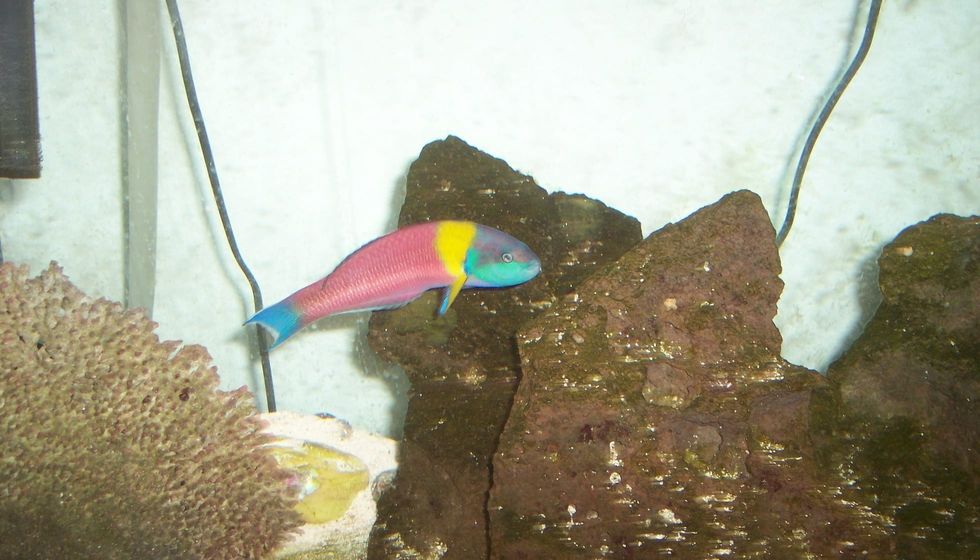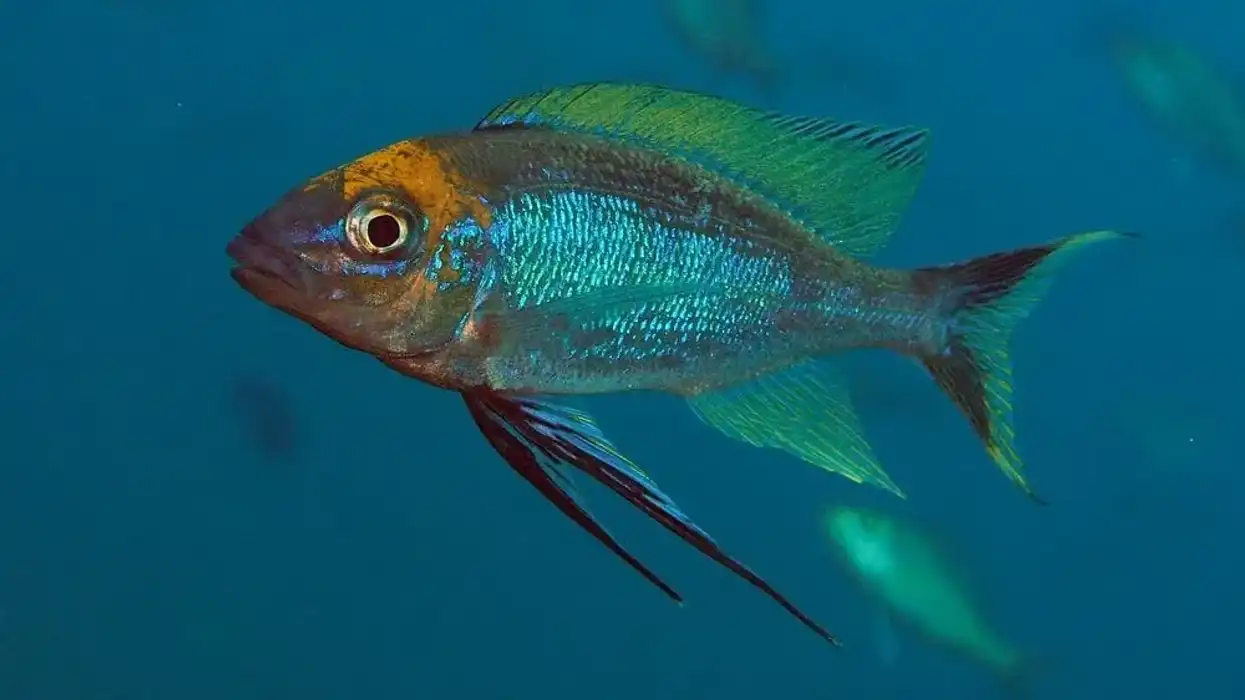If colors are your thing then you will love the Cortez rainbow wrasse!
This colorful fish has been the pride of several home aquariums, and for a small price, can be there to improve the colors of your aquarium too!
However, it is best to get a tropical fish like this when it is a juvenile, or when it is in the phase to become an adult. It is concentrated in several locations, such as off the Peruvian coast, on the famous Galapagos Islands, and various other places all over the Atlantic Ocean.
This tropical fish, even when juvenile, is one of the most colorful fish around, swimming in groups of 50-60 individuals much like many other schools of fish in the same waters.
There is so much to learn about this wonderful little fish, and definitely something to check out if you are considering adding this little one to your aquarium. In addition, you can also check out several other equally adorable and wonderful fish like the guppy and the rainbow trout.
Cortez Rainbow Wrasse Interesting Facts
What type of animal is a Cortez rainbow wrasse?
This wrasse, Thalassoma lucasanum, is a type of fish.
What class of animal does a Cortez rainbow wrasse belong to?
This aquarium reef fish wrasse, Thalassoma lucasanum, belongs to the class Actinopterygii.
How many Cortez rainbow wrasses are there in the world?
Wrasses belong to the Labridae family of marine fish, which includes several vividly colored species. Including over 600 species across 81 genera, the family is big and diversified. However, the estimated population of Cortez rainbow wrasse is unknown.
Where does a Cortez rainbow wrasse live?
They live in the ocean. The Cortez rainbow wrasse is a wrasse found in the Eastern Pacific Ocean, throughout Baja, California, Peru, and the Galapagos Islands.
What is a Cortez rainbow wrasse's habitat?
They enjoy open water as well as rocky hideouts to avoid predators. Rainbow wrasses can be found in depths of shallow reefs up to 160 ft (40 m) deep. When we think about Cortez rainbow wrasse, Galapagos Islands, the first place that we think of. It's also available in aquarium stores.
Who do Cortez rainbow wrasses live with?
Specifically, these Pacific coral fish species, of family Labridae, live in small schools or groups.
How long does a Cortez rainbow wrasse live?
Due to a paucity of research, the lifespan of this wrasse, Thalassoma lucasanum, is undetermined. Humphead wrasse reef fish have a long life span in addition to their big size. They have been observed in the wild to live for nearly 30 years.
How do they reproduce?
There are two sorts of males and two ways to reproduce in the Mexican rock wrasse fish. Males and females are both in the color phase with transverse red and yellow bands.
They breed by spawning in large groups. Large groups of females and males emerge from the water's surface, release sperm and eggs at the surface of the water columns, and then return to the near-bottom environment.
A "terminal male" is a female wrasse that has changed into a male.
Wrasse male fish replicates by building a harem and mating with females chosen specifically for him. Usually, each wrasse populace has only a single sexually active terminal male, which is quickly restored by a female recently turned into a terminal male if it is removed.
What is their conservation status?
Their conservation status is of Least Concern according to the IUCN.
Cortez Rainbow Wrasse Fun Facts
What do Cortez rainbow wrasses look like?

They are primarily black as a juvenile, with a pink and yellow belly. Their body coloration becomes bright when they grow older, resulting in a rainbow of colors.
Their body turns a reddish tint, while their head and fins turn a blue and green color. A vivid yellow band positioned directly behind the head adds to the mature fish's beauty. These are among the genus's smallest wrasses, and they make an excellent addition to a sea fish-only aquarium.
How cute are they?
As their name suggests, rainbow coloring, including bright green, yellow and red, having a band behind the head makes them one of the cutest and prettiest fish.
How do they communicate?
The communication methods of these green-colored body fish found in the depth of up to 160 ft (40 m) deep are undescribed.
How big is a Cortez rainbow wrasse?
Adult wrasse reef fish range from around 2in (5 cm ) to 6.5 feet (2 m) or more in length. However, the average length of these aquarium fish is around 6in (15.2 cm).
How fast can a Cortez rainbow wrasse swim?
This tank fish wrasse is often seen swimming in huge loose bunches of 50 or even more fish, but their exact speed is unclear.
How much does a Cortez rainbow wrasse weigh?
The average body weight of an adult Cortez rainbow wrasse, native to California, is unknown due to deficient research.
What are the male and female names of the species?
Female and males of this reef species don't have any specific names.
What would you call a baby Cortez rainbow wrasse?
The baby of the Thalassoma lucasanum wrasse species has no special title.
What do they eat?
Carnivorous, Pacific rainbow wrasse eat tiny hard-shelled types of invertebrates, worms, crustaceans, shrimp, and fish in the wild. They will eat pellets, frozen food, and flake food in a household aquarium.
Your wrasse will benefit from a broad diet and the finest nutrients if you mix all of these things. They also consume a meaty diet as well as high-quality pellet feed and marine flake. Invertebrates are the major diet of wrasse species.
Are they dangerous?
These sea fish native to California, with reasonable body size and length, eat invertebrates, crustaceans, and shrimp and are not hazardous.
Would they make a good pet?
In the aquarium, the Cortez rainbow wrasse is energetic, tough, and long-lived. Despite being smaller than most of these wrasses, it is nevertheless highly active throughout the day and will require plenty of swimming space.
It will also require many stony corals with crannies and nooks for retreating and resting at night. Juveniles may act as cleaners at times, but as adults, they become hostile.
It's a great fish for a community aquarium if the other fish in the tank have a similar temperament. This wrasse isn't particularly fond of corals, although it does consume crabs, invertebrates, and small fish.
Snails and hermit crabs are the natural diet of this species, so caution should be exercised if they are kept in an aquarium with these invertebrates. These fish can be maintained one per tank, although bigger tanks benefit from a small group.
Did you know...
Both reef species, the blue-headed wrasse and Cortez rainbow wrasse belong to the similar family Labridae and genus Thalassoma.
Although wrasse is edible, it is not a famous food fish.
Why is it called Cortez rainbow wrasse?
This wrasse is named from its natural habitat, the Sea of Cortez, and its vibrant rainbow color. The Cortez rainbow wrasse, as all Thalassoma Lucasanum wrasses, has more than one color phase, and this species has two with a band behind the head found in the depth of deep waters.
What's unique about the Cortez rainbow wrasse?
Because these Mexican rock wrasse or rainbow wrasse fish use their pectoral fins being their primary source of propulsion, these marine wrasses swim in a characteristic up-and-down manner.
Here at Kidadl, we have carefully created lots of interesting family-friendly animal facts for everyone to discover! Learn more about some other fish from our rainbow cichlid facts and saw shark facts pages.
You can even occupy yourself at home by coloring in one of our Cortez rainbow wrasse coloring pages.










